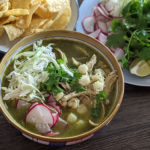Maria Alvarado and Lupe Olguin:
Friends, classmates, catering partners
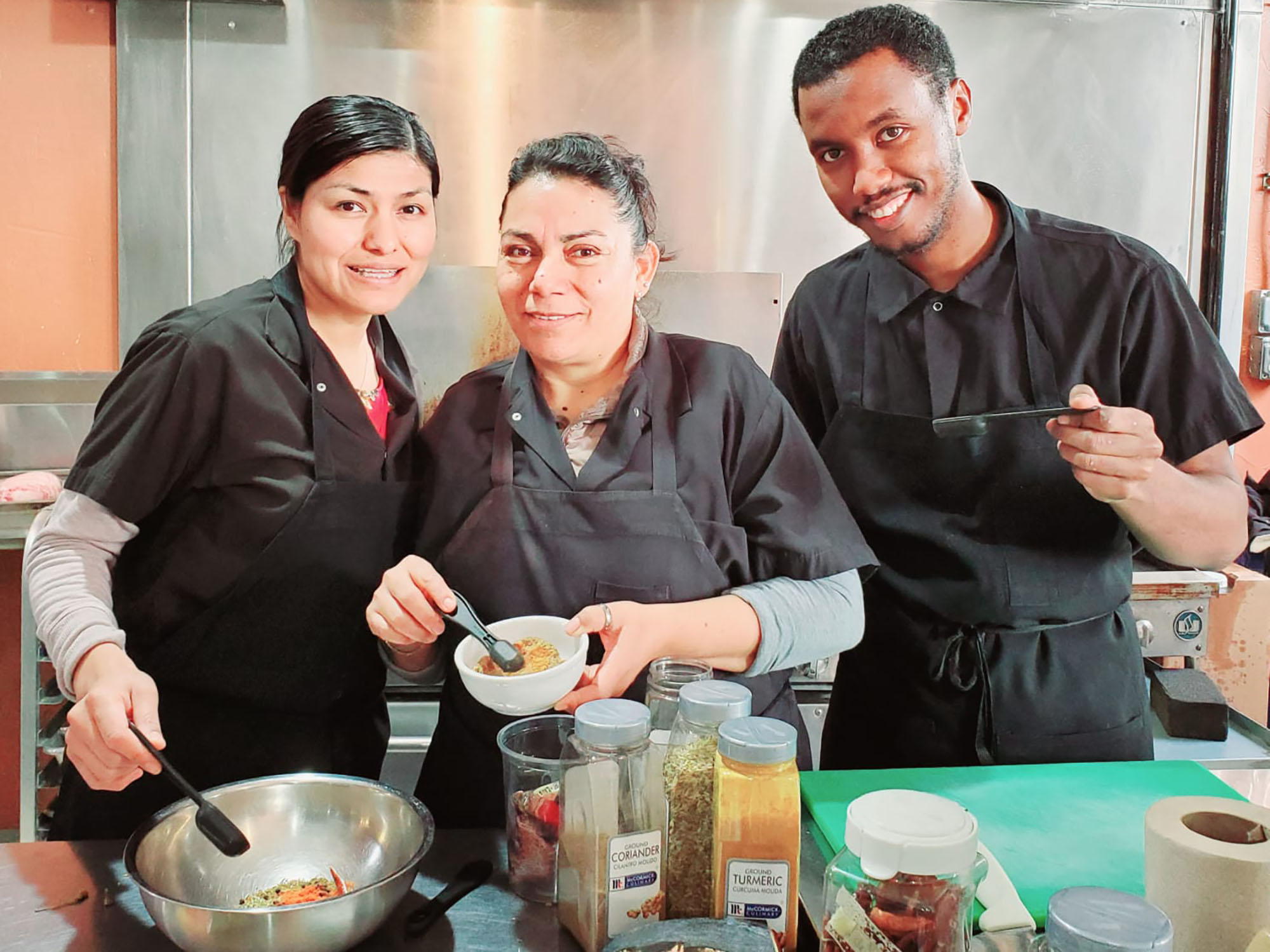
“The kind of food we offer is maybe more simple,
but the flavor is more natural.”
Maria Alvarado and Lupe Olguin have shared a love of cooking and a deep friendship for more than 15 years. After graduating together from the Project Feast apprenticeship, they also hope to share a catering business someday.
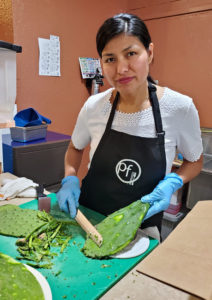
Maria Alvarado prepares nopales (prickly pear). Top photo: Maria, Lupe and classmate Mohamed Ali.
Maria Alvarado and Guadalupe “Lupe” Olguin share laughter and life stories as easily as the pozole and enchiladas they make together in the Ubuntu Street Cafe kitchen. Both women grew up in small cities in central Mexico – Maria is from Irapuato, Guanajuato, and Lupe is from Pachuca, Hidalgo – and they savor childhood memories of family meals full of produce fresh from the garden.
Maria came to Seattle first, in 2000, and Lupe arrived a few years later after living in Las Vegas. When the two young mothers met at a mutual friend’s house in Seattle, they quickly became friends. Their families grew together – Maria now has four children ages 2 to 15 and Lupe has three ages 8 to 16 – and the women found joy in their friendship as their lives took root in the rainy Pacific Northwest.
Over the years, Maria and Lupe discovered a passion for cooking the fresh, healthy flavors of home. So, when Lupe learned about Project Feast in 2019, she of course told Maria about the program. They enrolled together, wrote recipes together – adding a drizzle of chipotle mayonnaise to the tacos de pescado they served at popups together – and as graduates, now plan to open a catering business together. They haven’t settled on a name for the business, but they have a leading candidate: Sister Salsas.
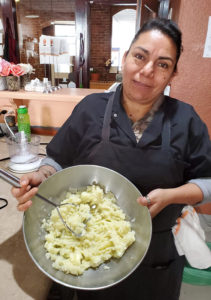
Lupe Olguin mashes potatoes in the Ubuntu Street Cafe kitchen.
Just before graduation in December 2019, as they juggled the demands of schoolwork, family commitments and a couple of big Project Feast catering jobs, Maria and Lupe sat down to talk about their memories of favorite foods from Mexico, the dishes they enjoy cooking most and their hopes for working together in the future.
When did you learn to cook?
Maria: “When I came here and got married, I started to cook. In Mexico when I was young, I just cooked eggs and boiled vegetables. I helped my mom and watched. I saw my mom make tortillas. Because she was a hard worker, all my brothers and sisters and I stood around her when she was cooking, and we were eating at the same time. When she was making tortillas, she was also frying potatoes or zucchini. We saw how she cooked very simply, just with tomatoes, onions, cilantro.
“When my father was alive, he had a huerta [vegetable garden] where he would plant strawberries, onions and all kinds of vegetables. We would help. We knew the names and we were very familiar with how they smell. And that’s how I learned.”
Lupe: “I learned when I was a child. I grew up with my sister-in-law and she gave me some instructions: ‘You make this and put this in first.’ And this is how I learned to cook before I married. She taught me to make different kinds of chile rellenos and moles. In Mexico, we eat a lot of different moles.”
How did you learn about Project Feast?
Maria: “Lupe was studying at [Highline] College, and her teacher gave her a flyer that talked about Project Feast. And she told me about it. They offer kitchen classes, and you can still study English. We looked at this as a good opportunity to continue to grow and get money if we do catering. Because we have our children, we cannot go to work 10 hours every day. But if we do catering, we can do just weekends.”
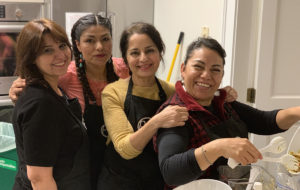
Project Feast kitchen assistant Maha Hassen, Maria Alvarado, Chef Instructor Kausar Ahmed and Lupe Olguin during Maria and Lupe’s apprenticeship in 2019.
What are some of the things you’ve learned through the program?
Maria: “We learned temperatures and how to run a commercial kitchen. Also, how to scale the recipes and how to write the recipes. And we did a menu. Our menu is a Mexican menu: Enchiladas, flautas, pozole, mole, tacos, estofado, pollo, sopes.
“Before, we didn’t have the information about the license we need to start. We learned we can rent a kitchen. Now, we have this information and can get the paperwork.”
What kind of food do you want to make in your catering business?
Maria: “We have the opportunity to do our food, Mexican, but we can do different food, too, like any food we’ve learned here. And we hope to explore and to create new dishes – like mix a little bit Mexican, a little bit Somalia – because here we study different cultures, and everybody likes to taste. We mix it up at home with friends. It’s very interesting, learning different ingredients.”
What foods do you enjoy making – and eating – the most?
Maria: “I like to make different kinds of enchiladas. You can put different things inside – chicken, beef, turkey, vegetables, whatever you want. And mole. Like Lupe says, in Mexico, every part of the country has different moles. In mine [Guanajuato], the mole is not spicy, it’s not sweet, and I like that mole. Green is a little more spicy. And in Puebla, the mole is more black and it is sweet. I like all kinds of moles, but every mole has a different kind of flavor. When we make it, we try to make a lot and then save it in little plastic bags, freeze, to keep.”
Lupe: “I like the green mole. You need a lot of ingredients, but it’s good.”
Maria: “I love cooking at home because I choose how healthy the food is for my children. I remember how healthy I grew up. My children almost never get sick, fevers, runny nose, and I think it’s because they eat healthy and get all the vitamins they need. And that’s why I choose to cook at home. I think it’s better.”
What foods remind you of home?
Maria: “Pozole.”
Rojo or verde?
Maria: “Both. In Mexico, we usually eat rojo with pork. It’s more traditional.”
Lupe: “Chicken asado. We marinate some chicken and put it on the grill. I think it’s easier when you don’t have as much time for making something. Carne asada, tacos dorados, sopes.”
How is cooking in Mexico different from other cuisines?
Maria: “Here, we see a lot of [dry spices] used for beef. But in Mexico, we don’t use any powder. We use the whole vegetable – tomatoes, onions, garlic, peppers. I feel like it’s more natural.”
Lupe: “We use only salt, pepper. And not too much.”
Maria: “We get the flavor from the vegetables. And in Mexico, we take more time with the food.”
Lupe: “More time, and it’s more delicious.”
Maria: “The kind of food we offer is maybe more simple, but the flavor is more natural. And that’s what we want to do together, me and Lupe.”
– Interview lightly edited for length and clarity. Interview and writing by Denise Clifton, Tandemvines Media
Pozole Verde by Maria Alvarado
Ingredients
Stock:
- 1 whole chicken, chopped into 4 sections
- 4 ½ quarts water
- 4 garlic cloves, peeled
- ½ onion
- 1 tbsp salt
- 3 ½ lbs hominy
Salsa:
- 10 tomatillos
- 4 poblano chiles
- 6 cloves garlic, peeled
- 1 onion, quartered
- 1 tbsp fresh oregano
- 4 ripe avocados
- 1 bunch cilantro
- 5 oz spinach
- 1 head of green lettuce
- 1 tsp salt
Toppings:
- Shredded cabbage
- Thinly sliced radish
- Sliced jalapeño
- Cilantro
- Lime
- Tortilla chips
Instructions
To make the stock:
- 1. Put everything but the hominy in a large pot. Bring to a boil. Lower heat and simmer for 45 minutes (or until chicken is cooked through), skimming off any foam that comes to the surface.
- 2. Remove the solids, and discard the garlic and onion. Let the chicken cool, then shred.
- 3. While the chicken is cooling, add the hominy to the stock and bring to a boil. Lower the heat and add the salsa. Simmer for 45 minutes
Making the salsa:
- 1. Roast tomatillos, poblano, garlic and onion in a 450 degree oven for 20 to 30 minutes — until the vegetables are soft and starting to brown. Transfer the roasted vegetables to a blender.
- 2. Add the oregano, avocados, cilantro, spinach, lettuce and salt. Blend until completely processed.
- 3. Add salsa to the stock as directed above.
- Check for seasoning, add more salt if desired.
To serve:
- Ladle into bowls and top with shredded cabbage, sliced radish, sliced jalapeños, cilantro, a squeeze of lime and tortilla chips.
- Serves 12
Tortilla Soup by Guadalupe Olguin
Ingredients
For the salsa:
- 2 dried pasilla chiles
- 1 ancho chile
- 1 lb tomatoes, cut into large chunks
- 3 cloves garlic, minced
- ½ onion, sliced
- 1 ½ quarts chicken stock
- Leaves from 2 epazote sprigs
- Salt to taste
Toppings:
- 12 corn tortillas, julienned
- Queso
- 1 avocado, sliced for serving
Instructions
- 1. Soak the pasilla and ancho chilis in hot water for 30 minutes. Stem and seed, set aside.
- 2. Saute the onion in a little oil. When the onions are translucent, add the garlic. Cook for a minute and then add the tomatoes and cook until the tomatoes are tender (about 5 more minutes). Transfer tomatoes, onions, and garlic to a blender. Add the chilis and blend.
- 3. In a large pot, bring the salsa to a simmer. Cook for a few minutes (until it starts to smell good), then add the chicken stock and bring to a boil. Lower heat to a simmer. Add the epazote and season with salt.
- 4. Serve topped with tortillas, queso, and sliced avocado
- Serves 3 to 4

